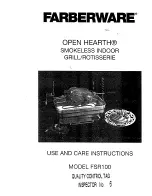
Safe use of Kerosene and Gas Oil.
These fuels give off a flammable vapour when heated
moderately. Vapour ignites easily, burns intensely and
may cause explosion. The vapour can follow along at
ground level for considerable distances from open
containers and spillages collecting as an explosive
mixture in drains, cellars, etc.
Fuels remove natural oils and fats from the skin and
this may cause irritation and cracking of skin. Barrier
cream containing lanolin is highly recommended
together with good personal hygiene.
Gas oil may also cause irreversible damage to health
on prolonged or repeated skin contact.
Always store fuels in a properly constructed and
labelled tank. Always handle fuel in open air or well
ventilated space away from sources of ignition and
refrain from smoking.
Always drain fuel using a proper fuel retriever, funnel
or mechanical siphon. Never apply heat to a fuel tank,
container or pipework. Never siphon fuel through
tube by mouth. If accidentally swallowed contact
doctor immediately and do
NOT
induce vomiting.
Avoid inhaling fuel vapour as this can cause light
headedness and seriously impair judgement.
3
Under the Consumer Protection Act 1987 and
Section 6 of the Health and Safety Act 1974, we are
required to provide information on substances
hazardous to health.
I
NSULATION AND
S
EALS
Ceramic Fibre, Alumino - Silicone Fibre material are
used for boards, ropes and gaskets. Known hazards
are that people may suffer reddening and itching of
the skin. Fibre entering the eye will cause foreign
body irritation. It may also cause irritation to the
respiratory tract.
Precautions should be taken by people with a history
of skin complaints or who may be particularly
susceptible to irritation. High dust levels are only
likely to arise following harsh abrasion.
Generally, normal handling and use will not give
discomfort. Follow good hygiene practices, wash
hands before consuming food, drink or using the
toilet.
First Aid - Medical attention should be sought
following eye contact or prolonged reddening of the
skin.
The small quantities of adhesives and sealants used in
the product are cured. They present no known
hazards when used in the manner for which they are
intended.
1.
Switch off all electrical and other ignition
sources.
2.
Remove all contaminated clothing to safeguard
against fire risk and skin damage. Wash affected
skin throughly with soap and water and remove
clothing to a safe well ventilated area and allow
to air before cleaning.
3.
Contain and smother the spill using sand or
other suitable non-combustible material.
4.
Do not allow fuel to escape into drains or water
courses. If this happens, contact Fire Brigade
and Local Water Authority.
5.
Consult local Authority about disposal of
contaminated soil.
If fuel is accidentally swallowed:-
* Seek medical attention immediately. Do NOT
induce vomiting.
If fuel is splashed into eyes:-
* Wash out with running water for at least ten
minutes and seek medical attention.
1
FIRST AID
1
FUEL SPILLAGE
1
SAFETY
1
HEALTH & SAFETY
INFORMATION
THIS PRODUCT HAS BEEN DESIGNED
TO THE FOLLOWING STANDARDS:
EMC Directive
(Electromagnetic compatibility) 89/336/EC
Standards:
EN 61000-6-1: Electromagnetic Compatibility Generic
Standard - Immunity for residential, commercial and
light industrial environments. (Feb.2001)
EN 61000-6-3: Electromagnetic Compatibility Generic
Standard - Emission standard for residential,
commercial and light industrial environments.
(Feb.2001)
LV Directive
(Low voltage) 73/23/EEC
Standard:
IEC 60335-1: Household and similar electrical
appliances - Safety (May 2001)
Boiler Efficiency Directive 92/42/EEC
Standard:
BSEN 304: Oil boilers with forced draft burners.
Summary of Contents for Combi 120
Page 10: ...2 TECHNICAL SPECIFICATION 9 2 E F Riello Burner Specification...
Page 31: ...30...
Page 32: ...Combi Oil Boiler PART 2 Sealed System Domestic Hot Water 31...
Page 40: ...39 Combi Oil Boiler PART 3 Spare Parts...
Page 41: ...9 FAULT FINDING 40 T Repair or Replace Oil Pump r No...
Page 52: ...NOTES...





































